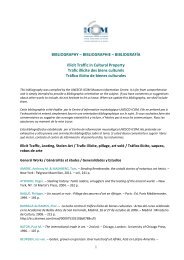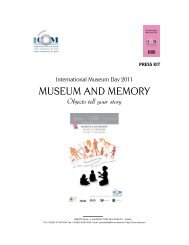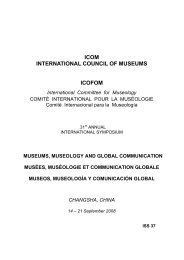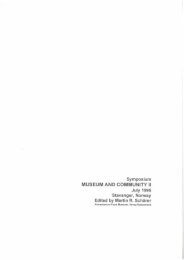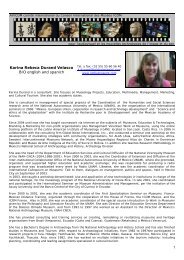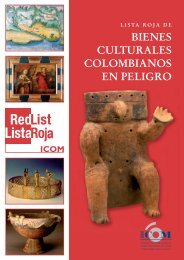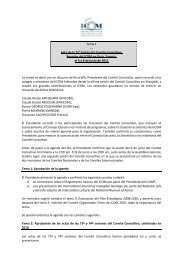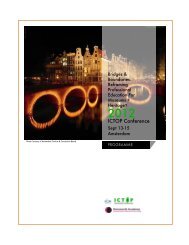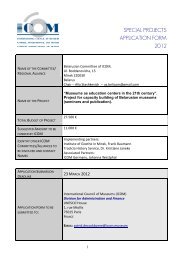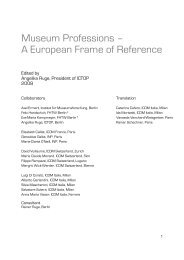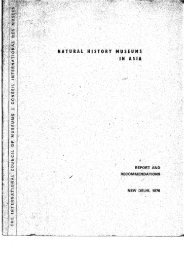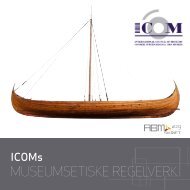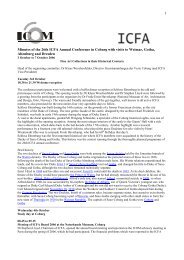Key Concepts of Museology - ICOM
Key Concepts of Museology - ICOM
Key Concepts of Museology - ICOM
Create successful ePaper yourself
Turn your PDF publications into a flip-book with our unique Google optimized e-Paper software.
ding even the museums <strong>of</strong> antiquity,<br />
which were more schools <strong>of</strong> philosophy<br />
than collections in the accepted<br />
sense <strong>of</strong> the term.<br />
4. This last use <strong>of</strong> the term<br />
museum brings us to the principles<br />
<strong>of</strong> the ecomuseum in its original<br />
conception, that is to say a museal<br />
institution which, for the development<br />
<strong>of</strong> a community, combines<br />
conservation, display and explanation<br />
<strong>of</strong> the cultural and natural heritage<br />
held by this same community;<br />
the ecomuseum represents a living<br />
and working environment on a given<br />
territory, and the research associated<br />
with it. “The ecomuseum […] on a<br />
given territory, expresses the relationship<br />
between man and nature<br />
through time and space on this territory.<br />
It is composed <strong>of</strong> property <strong>of</strong><br />
recognised scientifi c and cultural<br />
interest which is representative <strong>of</strong><br />
the community it serves: non-built<br />
immovable property, natural wild<br />
spaces, natural spaces occupied by<br />
man; built immovable property;<br />
movable property; fungible goods.<br />
It includes an administrative centre,<br />
headquarters <strong>of</strong> the major structures:<br />
reception, research, conservation,<br />
display, cultural action, administration,<br />
in particular one or more fi eld<br />
laboratories, conservation bodies,<br />
meeting halls, socio-cultural workshops,<br />
accommodation etc.; trails and<br />
observation points for exploring the<br />
territory; different architectural,<br />
archaeological and geological elements…duly<br />
indicated and explained”<br />
(Rivière, 1978).<br />
5. With the development <strong>of</strong> com-<br />
puters and the digital world the<br />
concept <strong>of</strong> cyber museum, <strong>of</strong>ten<br />
incorrectly called ‘virtual’, gradually<br />
became accepted; a notion generally<br />
defi ned as “a logically related collection<br />
<strong>of</strong> digital objects composed in a<br />
variety <strong>of</strong> media which, through its<br />
connectivity and its multi-accessible<br />
nature, lends itself to transcending<br />
traditional methods <strong>of</strong> communicating<br />
and interacting with visitors..;<br />
it has no real place or space; its<br />
objects and the related information<br />
can be disseminated all over the<br />
world” (Schweibenz, 1998). This<br />
defi nition, probably derived from<br />
the relatively recent notion <strong>of</strong> virtual<br />
computer memory, appears to<br />
be something <strong>of</strong> a misinterpretation.<br />
We must remember that ‘virtual’ is<br />
not the opposite <strong>of</strong> ‘real’, as we tend<br />
to believe too readily, but rather the<br />
opposite <strong>of</strong> ‘actual’ in its original<br />
sense <strong>of</strong> ‘now existing’. An egg is a<br />
virtual chicken; it is programmed<br />
to become a chicken and should<br />
become one if nothing gets in the<br />
way <strong>of</strong> its development. In this sense<br />
the virtual museum can be seen as all<br />
the museums conceivable, or all the<br />
conceivable solutions applied to the<br />
problems answered by traditional<br />
museums. Thus the virtual museum<br />
can be defi ned as a “concept which<br />
globally identifi es the problem areas<br />
<strong>of</strong> the museal fi eld, that is to say the<br />
effects <strong>of</strong> the process <strong>of</strong> decontextualisation/recontextualisation;<br />
a<br />
collection <strong>of</strong> substitutes can be a<br />
virtual museum just as much as a<br />
computerised data base; it is the<br />
59



